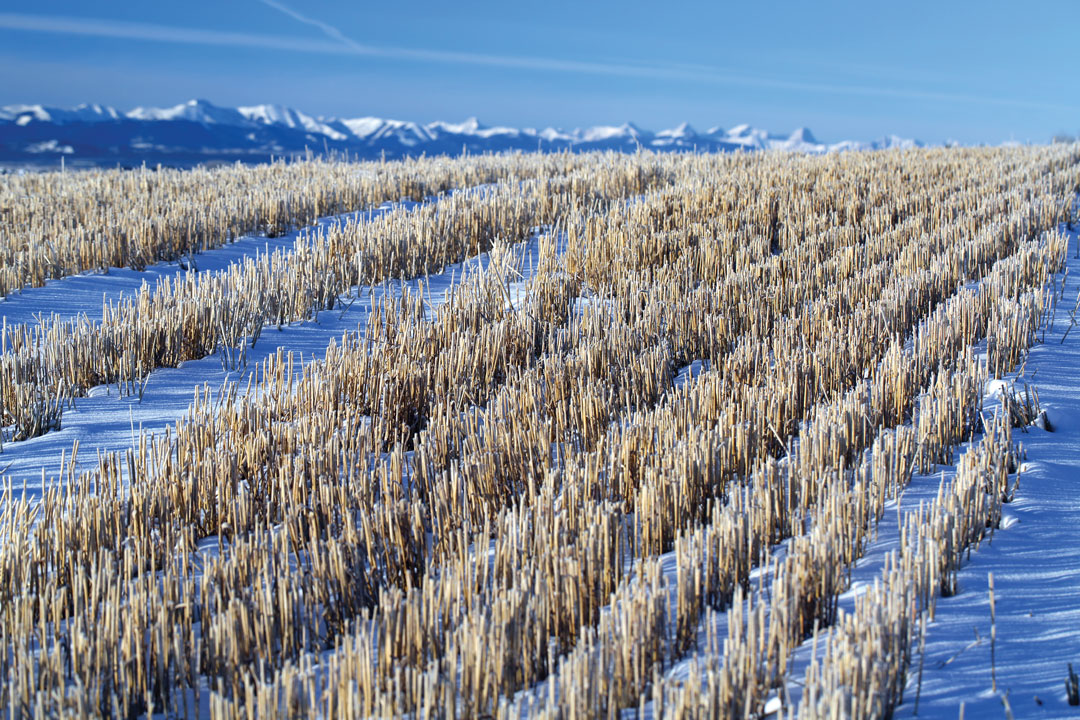WHEN IT RAINS, IT POURS
2017 CROP POTENTIAL JEOPARDIZED BY PREVIOUS YEAR’S UNHARVESTED ACRES
BY NATALIE NOBLE
Disastrously wet conditions and early snowfall in 2016 left many Alberta farmers contemplating carrying out harvest and spring planting simultaneously.
Thirty minutes west of Barrhead, Shane DeBock said that in mid-August roughly eight to 18 centimetres of rain kept farmers out of their fields for three weeks.
“From there on, it was a battle,” he said. “It was muddy, and in areas of high-clay soil it’s challenging to peel stuff off the ground. And everything was down, lodged flat.”
In late September, as DeBock managed to harvest 50 out of 370 acres of canola at 15.5 per cent moisture, he and other growers were again kept out of the fields by moisture.
“We dried it, and then it started to snow. After that, nobody in this area got back into the field,” he said.
In the early days of August, 2017 did not appear promising. Approximately a quarter of DeBock’s acres had not been seeded as he couldn’t get into his fields due to rain. However, by mid-August, the rain had let up and he was able to get some field work done.
Daniel Graham, manager, financial analysis, at Agriculture Financial Services Corporation (AFSC), said the magnitude of the unharvested 2016 crop and excessive spring moisture caused delays in spring threshing. “These conditions have caused an increase in unseeded acres for the 2017 crop year. Over 612,000 acres have been reported unseeded to AFSC,” he said. “This is well above the five-year average of 76,000 unseeded acres.”
Graham added that in anticipation of increased pre-harvest and wildlife inspection requests, AFSC streamlined its inspection processes early this year, extended the recommended seeding dates for several crops and increased the unseeded acreage benefit for the 2017 crop year. For example, in some cases, complete pre-harvest and wildlife assessments were based on declarations from farmers, removing the need to wait for field inspections, and zero-yields were assessed in situations where inspectors determined the crop unharvestable or unmarketable.
Graham said that AFSC strives to make its programs responsive and accountable to stakeholders. “The production insurance program responded to the unharvested acres in the manner in which it was designed to,” he said. “Over $33.6 million in advances were issued to producers significantly impacted by their insured acres that remained unharvested over winter. An additional $57 million in payments has been paid as of early August on finalized claims that previously reported unharvested acres in 2016.”
However, farmers and other ag professionals have expressed frustration with lengthy assessment timelines, claim repayment times and the harvesting of unusable crops to satisfy the claims process. Alberta crop commissions advised AFSC regularly and worked with the organization to identify and eliminate bottlenecks. While these consultations helped streamline the process, there are yet a number of areas that could be improved in the future.
“Crops as old as 400 days were being combined with no possible end use,” said Robert Saik, founder of Agri-Trend Global Business Development. “But in order to make a claim, farmers were still forced to combine and harvest these crops, putting the 2017 crop in jeopardy in addition to the previous year’s.”
Though his fields were assessed in early June, DeBock was not paid out until August 15. “I didn’t receive my advance cheque until after I’d made my in-crop loan payment,” he said. “I financed myself, pulled money out of RRSPs, whatever I had to do to make my payments.”
In addition to the financial toll, strong emotions come with these highly stressful situations for farm families.
“It’s difficult to understand the stress of trying to pull last year’s crop, dealing with extended payment negotiations with creditors, not having any cash available, staring at upwards of $1,000,000 in crop lying under the snow and the stress of unnecessary wear and tear on your equipment,” Saik said.
Still, Saik commended the ag community for pulling together, including farmers, banks, Farm Credit Canada and equipment manufacturers. “The agriculture community is resilient,” he said. “People have been understanding. They know the situation is out of the farmers’ control and they’re willing to work with them.”







Comments